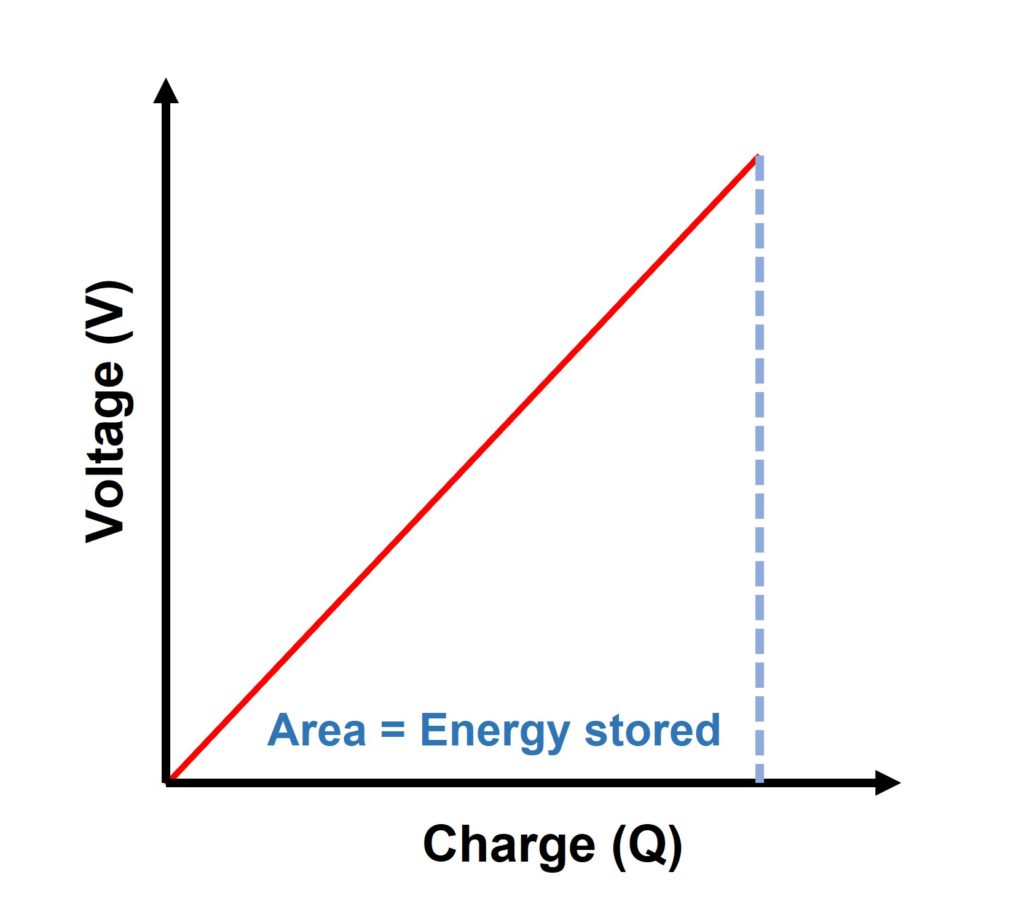A capacitor is a type of electrical component that is often seen in circuits. Its purpose is to hold an electrical charge.
In conventional parallel plate capacitors, charges of equal but opposite values are present on adjacent plates (for a spherical capacitor, there are concentric spheres instead of plates).
These charges generate an electric field between them, which contains an amount of the circuit’s energy.
The energy stored in a capacitor with a capacitance, C, and an applied voltage, V is equivalent to the work done by a battery to move the charge Q to the capacitor.
The resulting equation is:
E = 1/2 * C * V²
We may rewrite the capacity energy equation in two more comparable ways using the generic formula for capacitance, C = Q / V:
E = 1/2 * Q * V
Table of Contents
Derivation of energy stored in a capacitor Relation
The charge stored on the plates of a capacitor is exactly proportional to the potential difference across the plates. On a voltage-charge graph, this results in a straight line through the origin.
The area under this graph represents the energy stored in a capacitor.

Energy = Area = 1/2 base x height = 1/2 Q V
Energy = 1/2 CV2 (since Q = CV from the basic definition of charge)
Energy = 1/2 Q2/C (in case you don’t know the capacitance of the material)
Applications of Capacitor Energy
When a capacitor is connected to an electric circuit, its principal function is to store electric energy. Even if it is detached from the electric circuit, it can utilize the stored energy and function as a temporary battery.
- Power factor correction: The method of adjusting for lagging current by providing a leading current by connecting capacitors to the source is known as power factor correction. A suitable capacitance is connected to ensure that the power factor is as near to unity as feasible.
- Applications of capacitors in sensors: Non-contact capacitive proximity sensors can detect the presence or absence of nearly any object, regardless of material. They make use of capacitance’s electrical property and the change in capacitance caused by a change in the electrical field around the active face of the sensor.
- Power Conditioning: Capacitors are connected in parallel with most electronic devices’ DC power circuits to smooth current fluctuations for signal or control circuits. For example, audio equipment uses many capacitors in this manner to shunt away the power line hum before it enters the signal circuitry.
- Tuning: Variable capacitors are used in tuning circuits of radios, television sets, and other devices that must isolate electromagnetic radiation at specific frequencies. A variable capacitor is coupled to a basic antenna transformer circuit in the circuit below.
- Coupling: A coupling capacitor is used in analog circuits to link two circuits such that only the AC signal from the first circuit may flow through to the next while DC is blocked. A coupling capacitor is a capacitor that allows an alternating current signal to be sent from one node to another.
- Decoupling: Decoupling capacitors are used to separate or disconnect two circuits. In other words, they separate alternating current from direct current or vice versa. In the case of an input voltage drop, a decoupling capacitor gives enough power to an IC to keep the voltage level steady.
Summary
A capacitor is a common type of electrical component found in circuits. Its function is to store an electrical charge. The energy stored in a capacitor with capacitance C and applied voltage V is comparable to the work done by a battery to convey the charge Q to the capacitor.
Frequently Asked Questions
1. What is surface charge density?
Surface charge density (σ) is the amount of charge per unit area, measured in coulombs per square meter (C⋅m−2), at any point in a two-dimensional surface charge distribution.
2. What is light energy definition?
Light energy is a kind of electromagnetic radiation that is visible to the human eye. Photons are the particles that makeup light, and they are like small packets of energy. The Sun is the nearest star to Earth and emits light energy. Check the full article “Light energy definition”.
3. What is microfarad?
A microfarad is a capacitance unit that is 0.000001 farad, or one-millionth of a farad. A microfarad is represented by the sign µF. The term is frequently utilized in alternating-current and audio frequency circuit applications as the capacitors found in them normally have a rating of 1 µF or more.
4. What are power units?
Power is defined as energy divided by time. The unit of power in the International System of Units (SI) is the watt (W), which is equal to one joule per second.
More Interesting Topics
- BCl3 Lewis Structure in four simple steps - November 1, 2023
- PH3 Lewis Structure in four simple steps - October 8, 2023
- PF3 Lewis structure in four simple steps - September 24, 2023

